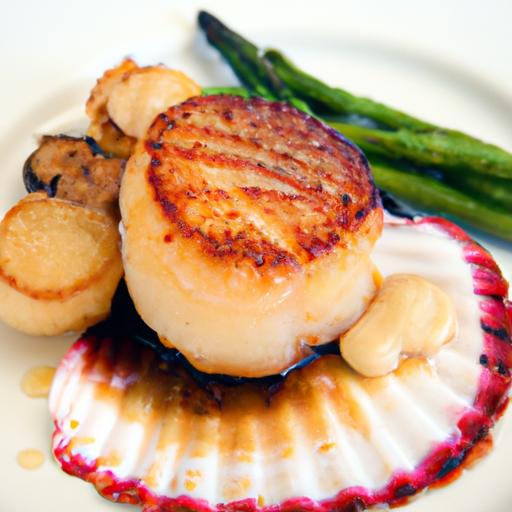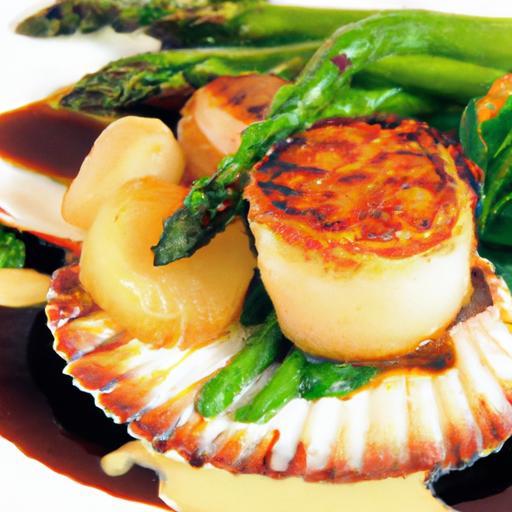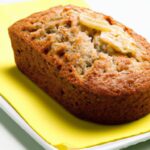There’s something almost magical about the sight-and sizzle-of scallops hitting a hot pan. Those small, tender morsels transform in minutes from pearly ivory to a golden-brown marvel, crowned with a crust that crackles beneath your fork. But achieving that perfect sear isn’t just luck or a toss of culinary fate; it’s science in motion. From the Maillard reaction to moisture control, the art of searing scallops is a delicate dance of heat, timing, and technique. In this article, we’ll unravel the chemistry and physics behind that irresistible crust, unlocking the secrets to elevate your scallop game from good to extraordinary.
Searing Scallops: Mastering the Maillard Magic for Perfectly Golden Crusts
Searing scallops is an art grounded deeply in the Maillard reaction, that magical chemistry responsible for the irresistible golden crust and rich, complex flavor. Achieving this perfect sear transforms simple scallops into a tender, caramelized delight that sings in every bite. Whether inspired by coastal cooking traditions or a personal love for tender seafood, mastering this technique elevates your culinary repertoire and ensures every plate dazzles.
Prep and Cook Time
Preparation Time: 10 minutes
Cooking Time: 6-8 minutes
Yield
Serves 4 as an appetizer or light entrée
Difficulty Level
Medium – Requires attention to detail and timing for the perfect sear
Ingredients
- 16 large sea scallops, patted dry
- 2 tablespoons unsalted butter
- 2 tablespoons high smoke point oil (grapeseed or avocado oil)
- Salt and freshly ground black pepper, to taste
- 1 teaspoon lemon zest (optional, for brightness)
- Fresh herbs such as thyme or parsley, finely chopped (for garnish)
- 1 tablespoon freshly squeezed lemon juice
Instructions
- Prepare the scallops: Begin by rinsing the scallops gently under cold water, then pat them completely dry with paper towels. Remove the side muscle if attached – this small rectangular “foot” can be chewy. Season both sides generously with salt and pepper to enhance flavor and promote Maillard crust formation.
- Select the right pan and heat: Place a heavy-bottomed stainless steel or cast iron skillet over medium-high heat. Add the oil and heat until shimmering but not smoking to unlock optimal searing conditions without burning the fat.
- Begin searing: Carefully place each scallop flat side down, spacing them evenly to avoid overcrowding which steams the scallops rather than searing. Let them cook undisturbed for approximately 2-3 minutes. Look for a beautifully golden crust forming around the edges-a sign of Maillard magic at work.
- Flip and finish: Use tongs to gently flip each scallop and add the butter to the pan. Tilt the pan slightly and spoon the melted butter over the scallops repeatedly to infuse rich flavor. Cook for another 1-2 minutes until opaque and just firm to the touch. Avoid overcooking to keep the inside tender and juicy.
- Rest and serve: Transfer scallops to a warm plate and let rest for 2 minutes. This pause allows juices to redistribute, ensuring a moist, succulent bite when served. Finish with a squeeze of lemon juice, a sprinkle of lemon zest, and a scattering of fresh herbs to elevate both texture and taste.
Chef’s Notes: Tips for Searing Scallops
- Dry scallops thoroughly: Excess moisture steals precious heat and prolongs cooking, preventing that crisp crust.
- Heat balance is crucial: Too low and the scallops will steam; too high and the exterior burns before the center cooks through.
- Use fresh, dry-packed scallops: Avoid “wet” scallops soaked in sodium tripolyphosphate; they won’t sear well.
- Resting is a must: Rest scallops briefly to maximize juiciness and enhance flavor integration.
- Substitutions: For dairy-free, swap butter with clarified butter or extra oil but watch flavor depth.
- Make-ahead: Scallops are best cooked fresh; however, dry and season then refrigerate up to 1 hour before searing for time-saving.
Serving Suggestions
Present your golden crusted scallops atop a creamy cauliflower purée, alongside sautéed garlic spinach, or nestled on a bed of vibrant microgreens. Garnish with delicate herbs and a final drip of lemon-infused olive oil to make the dish visually stunning and memorable. Pair with a crisp white wine like Sauvignon Blanc for an elegant dining experience.
| Nutrient | Per Serving (4 Scallops) |
|---|---|
| Calories | 150 kcal |
| Protein | 24 g |
| Carbohydrates | 2 g |
| Fat | 5 g |
Explore more seafood searing techniques or deepen your culinary science knowledge at Science of Cooking: The Maillard Reaction.

Q&A
Q&A: Searing Scallops – The Science Behind Perfectly Golden Crusts
Q1: Why is it so challenging to achieve a perfectly golden crust on scallops?
A: Scallops are like delicate little sea treasures-plump and tender inside, but prone to sticking, overcooking, or ending up sad and rubbery. The challenge lies in balancing heat, moisture, and timing just right so the surface crisps up beautifully without turning the interior into a chewy chore.
Q2: What’s happening scientifically when scallops develop that golden crust?
A: That irresistible crust is thanks to the Maillard reaction-a magical chemical dance between amino acids and sugars when exposed to high heat. This reaction forms complex flavor compounds and browning, transforming bland scallops into luscious bites bursting with umami and caramelized notes.
Q3: How does moisture impact searing scallops?
A: Water is the enemy of a crisp sear. When scallops are wet, they steam rather than sauté, preventing that golden crust. Patting them dry before cooking reduces surface moisture, allowing the pan to reach the high temperatures necessary for the Maillard reaction to work its charm.
Q4: Why is heat control important, and what temperature should the pan be?
A: The pan needs to be hot enough to trigger the Maillard reaction-typically around 300°F (150°C) or higher-but not so hot that the scallops burn before cooking through. Medium-high heat usually hits this sweet spot. Preheating the pan ensures that the scallops begin to brown the instant they touch the surface.
Q5: Does the type of cooking fat matter?
A: Absolutely! Oil with a high smoke point-like grapeseed, avocado, or refined olive oil-lets you crank up the heat without burning, maintaining that clean, golden crust. Butter adds flavor but tends to brown and burn quickly, so it’s often best added toward the end or combined with oil for balance.
Q6: How long should you sear scallops to get that perfect crust?
A: Timing is a delicate dance-usually 1.5 to 2 minutes per side. This is enough to form the crust while keeping the interior tender and juicy. Overcooking causes scallops to become rubbery, while undercooking leaves them pale and unappetizing.
Q7: Can scallops be seared straight from the fridge?
A: Bringing scallops closer to room temperature before searing helps them cook evenly-avoiding that temperature shock which can lead to uneven crusts or undercooked centers. A quick 15-minute rest outside the fridge works wonders.
Q8: Any tips to enhance the crust beyond the basics?
A: Yes! Sprinkle scallops lightly with salt right before searing-salt draws out moisture initially but then helps form a crisp exterior as it dissolves and caramelizes. Avoid overcrowding the pan to keep temperatures steady, and resist the urge to move scallops too much while searing-they need stillness to form that coveted crust.
Mastering the science behind searing scallops is like unlocking a little culinary secret. With dry scallops, blazing heat, good oil, and a mindful watch, you can achieve that perfect golden crust-the hallmark of a truly extraordinary scallop dish.
Insights and Conclusions
As the last hints of heat kiss your scallops to a golden perfection, remember that behind every crispy crust lies a delicate dance of science and art. From the Maillard reaction painting each scallop with rich flavor to the careful control of temperature and moisture, searing is more than just cooking-it’s transformation. So next time you hear the satisfying sizzle, know you’re witnessing chemistry in motion, turning simple seafood into a culinary masterpiece. Embrace the science, trust the technique, and savor the magic of searing scallops to golden bliss.

